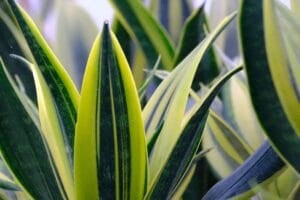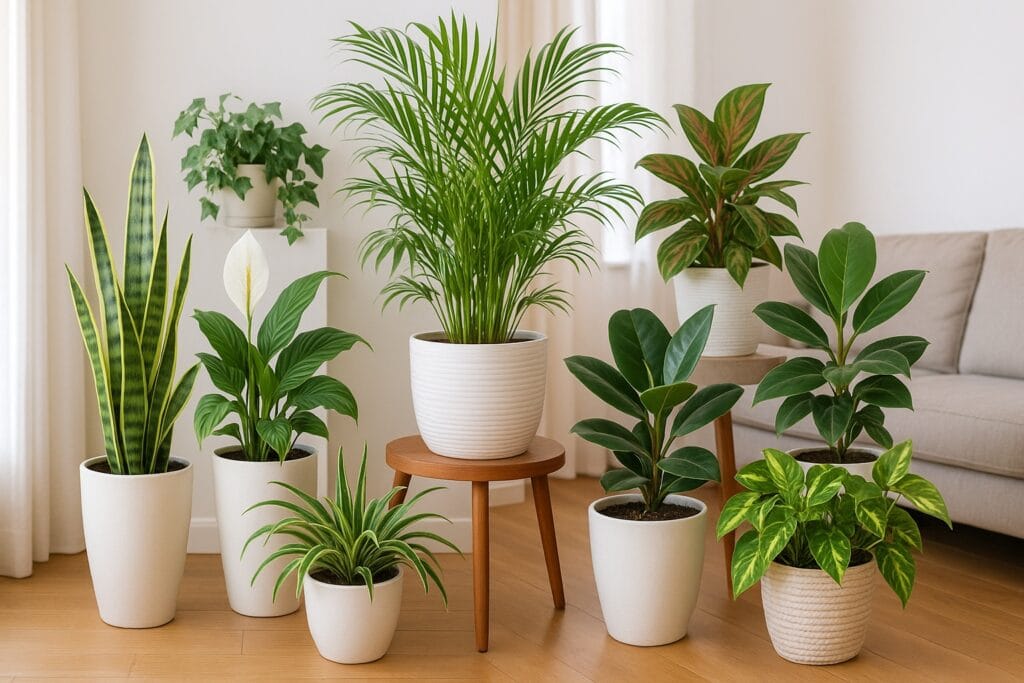12 Best Houseplants for Purifying Indoor Air
Introduction
We spend nearly 90% of our time indoors, where air quality can be worse than outside due to pollutants from furniture, paints, cleaning products, and cooking. Fortunately, nature has a solution—air-purifying houseplants. These green companions don’t just add beauty to your home—they help remove toxins like benzene, formaldehyde, and trichloroethylene from the air, according to NASA’s Clean Air Study.
In this guide, we’ll explore 12 of the best houseplants for purifying indoor air—from easy-to-grow species to bold statement plants. Whether you’re a seasoned gardener or a beginner, you’ll find the perfect plant to create a cleaner, greener indoor environment.
1. Snake Plant (Sansevieria trifasciata)

Common Names: Mother-in-law’s Tongue, Viper’s Bowstring Hemp
Air-Purifying Benefits: Removes benzene, formaldehyde, trichloroethylene, xylene, and toluene.
Best For: Bedrooms, offices, low-light areas
The snake plant is a must-have for purifying the air. It releases oxygen at night, making it ideal for improving bedroom air quality while you sleep. Its sword-like leaves and low-maintenance nature make it perfect for busy people or beginners.
Care Tips:
Snake plants thrive in low to bright indirect light and require minimal watering—allow the soil to dry completely between waterings. They’re drought-tolerant and perfect for beginners. Avoid overwatering to prevent root rot. Keep them in well-draining soil and a pot with drainage holes. Wipe leaves regularly to keep them dust-free and healthy.
2. Peace Lily (Spathiphyllum spp)

Air-Purifying Benefits: Absorbs formaldehyde, benzene, and trichloroethylene
Best For: Living rooms, bathrooms, shady corners
Peace lilies are not just stunning—they’re powerful air filters. With their glossy leaves and white blooms, they bring elegance to any room while tackling household VOCs (volatile organic compounds).
Care Tips:
Peace lilies thrive in low to medium indirect light and prefer consistently moist soil. Water them when the top inch feels dry, and avoid overwatering to prevent root rot. Wipe leaves regularly to keep them dust-free. They enjoy high humidity, so occasional misting helps. Fertilize monthly during the growing season. Keep away from pets, as the plant is toxic if ingested.
3. Spider Plant (Chlorophytum comosum)

Air-Purifying Benefits: Removes carbon monoxide, formaldehyde, and xylene
Best For: Hanging baskets, windowsills
One of the easiest indoor plants to grow, the spider plant thrives even with some neglect. Its arching green-and-white leaves are charming, and it produces baby plantlets that you can repot or share.
Care Tips:
Spider plant care is simple and beginner-friendly. Place it in bright, indirect light, and water when the top inch of soil feels dry. Avoid overwatering, as the roots are prone to rot. Trim brown leaf tips regularly and repot if root-bound. Spider plants also enjoy occasional misting and thrive in hanging baskets with good airflow.
4. Aloe Vera (Aloe barbadensis Miller)

Air-Purifying Benefits: Filters formaldehyde and benzene
Best For: Kitchens, sunny windows
Known for its healing gel, aloe vera is also a great air-cleaning plant. It removes toxins found in cleaning products and paints, making it perfect for the kitchen.
Care Tips:
Aloe vera thrives in bright, indirect sunlight and well-draining soil. Water deeply but infrequently—allow the soil to dry completely between waterings. Avoid overwatering to prevent root rot. Use a cactus or succulent potting mix for best results. Place in a sunny window and rotate occasionally for even growth. Fertilize lightly once during spring or summer.
5. Rubber Plant (Ficus elastica)
Air-Purifying Benefits: Removes formaldehyde from indoor air
Best For: Corners of living rooms or hallways
This bold, dark-leafed beauty is a favorite among interior designers. The rubber plant is not only visually striking—it’s also effective at filtering pollutants from your air.
Care Tips:
Rubber plant care is simple and rewarding. Place it in bright, indirect light and keep the soil slightly moist—water when the top inch feels dry. Wipe leaves regularly to remove dust and promote healthy growth. Avoid overwatering, as it can lead to root rot. During the growing season, feed monthly with a balanced liquid fertilizer for best results.
6. Boston Fern (Nephrolepis exaltata)

Air-Purifying Benefits: Removes formaldehyde and xylene
Best For: Bathrooms, high-humidity rooms
The Boston fern thrives in humid environments and is an excellent natural humidifier. It’s a graceful addition to hanging baskets or plant stands.
Care Tips:
Boston Fern thrives in humid, shady environments. Keep its soil consistently moist but not soggy, and mist the fronds regularly to maintain humidity. Place it in indirect light and avoid direct sun. Use well-draining soil and fertilize monthly during growing seasons. Ideal for bathrooms, this fern benefits from occasional trimming to remove dead or yellowing fronds.
7. Areca Palm (Dypsis lutescens)

Air-Purifying Benefits: Filters benzene, carbon monoxide, and formaldehyde
Best For: Living rooms, offices
The Areca Palm, also known as the butterfly palm, is a stylish indoor palm that naturally humidifies and detoxifies the air. It adds a tropical vibe to any space.
Care Tips:
Areca Palms thrive in bright, indirect light and prefer well-draining soil. Water the plant when the top inch of soil feels dry, but avoid overwatering. Keep humidity levels moderate and mist the leaves occasionally. Fertilize monthly during spring and summer. Prune yellowing fronds to encourage healthy growth. Avoid direct sunlight to prevent leaf burn.
8. English Ivy (Hedera helix)

Air-Purifying Benefits: Removes mold, benzene, and formaldehyde
Best For: Hanging baskets, topiaries, high shelves
English Ivy is known for its cascading foliage and excellent ability to filter airborne mold spores and toxins—making it ideal for allergy sufferers.
Care Tips:
English Ivy thrives in bright, indirect light but can tolerate low light. Keep the soil consistently moist, but avoid overwatering. Mist the leaves regularly to maintain humidity. Trim back leggy growth to encourage fullness. It prefers cooler indoor temperatures and benefits from occasional fertilization during growing months. Always use well-draining soil and a container with drainage holes.
9. ZZ Plant (Zamioculcas zamiifolia)

Air-Purifying Benefits: Removes xylene and toluene
Best For: Low-light areas, entryways
The ZZ Plant is practically indestructible. Its waxy, dark green leaves make it a great air-purifying option for homes with minimal sunlight.
Care Tips:
ZZ Plant thrives in low to bright indirect light and requires minimal watering—allow the soil to dry out between waterings. It prefers well-draining soil and doesn’t need frequent fertilizing. Clean the glossy leaves occasionally to boost photosynthesis. Avoid overwatering, as it’s prone to root rot. Ideal for beginners, this hardy plant tolerates neglect well.
10. Chinese Evergreen (Aglaonema)
Air-Purifying Benefits: Absorbs benzene and formaldehyde
Best For: Bedrooms, shaded corners
Chinese Evergreen is a colorful, low-light houseplant that’s also highly effective at purifying indoor air. Its pink, red, and silver foliage adds interest and flair to any interior.
Care Tips:
Chinese Evergreen is a low-maintenance plant that thrives in low to moderate light. Keep the soil slightly moist but avoid overwatering. It prefers warm, humid environments, so mist occasionally or use a humidity tray. Wipe leaves regularly to keep them dust-free. Fertilize monthly during the growing season. Avoid cold drafts and direct sunlight for best results.
11. Pothos (Epipremnum aureum)

Air-Purifying Benefits: Eliminates formaldehyde, benzene, and xylene
Best For: Hanging planters, bookshelves
Pothos, or Devil’s Ivy, is a fast-growing vine that’s incredibly forgiving and versatile. It’s especially good at absorbing VOCs from household items.
Care Tips:
Pothos thrives in low to bright indirect light and prefers well-draining soil. Water when the top inch of soil feels dry—avoid overwatering. Wipe the leaves to keep them dust-free for better air purification. It’s a fast-growing vine, so trim regularly to maintain shape. Ideal for beginners, Pothos adapts easily and tolerates neglect.
12. Bamboo Palm (Chamaedorea seifrizii)
Air-Purifying Benefits: Filters benzene, formaldehyde, and trichloroethylene
Best For: Large rooms, offices
This lush, easy-going palm adds life to your home while helping to clean your air. It’s also a natural humidifier and thrives indoors in containers.
Care Tips:
To keep your bamboo palm healthy, place it in bright, indirect light and maintain consistently moist soil—never let it dry out completely. Use well-draining potting mix and mist the leaves to boost humidity. Avoid direct sunlight, which can scorch its fronds. Feed monthly during the growing season with a balanced liquid fertilizer for lush, vibrant growth.
Quick Overview
| Plant Name | Best For | Pet-Friendly | Major Pollutants Removed |
| Snake Plant | Bedrooms | No | Benzene, Formaldehyde, Toluene |
| Peace Lily | Bathrooms, Living Room | No | Benzene, Trichloroethylene |
| Spider Plant | Hanging Baskets | Yes | Carbon Monoxide, Formaldehyde |
| Aloe Vera | Kitchens | No | Formaldehyde, Benzene |
| Rubber Plant | Living Room Corners | No | Formaldehyde |
| Boston Fern | Bathrooms | Yes | Formaldehyde, Xylene |
| Areca Palm | Offices | Yes | Benzene, Carbon Monoxide |
| English Ivy | Topiaries, Baskets | No | Mold, Benzene, Formaldehyde |
| ZZ Plant | Entryways | No | Xylene, Toluene |
| Chinese Evergreen | Bedrooms | No | Benzene, Formaldehyde |
| Pothos | Shelves, Baskets | No | Benzene, Formaldehyde, Xylene |
| Bamboo Palm | Living Rooms | Yes | Formaldehyde, Trichloroethylene |
Tips for Maximizing Air Purification Indoors
- Use multiple plants: NASA recommends at least one plant per 100 square feet of space.
- Keep leaves clean: Dusty leaves reduce a plant’s ability to purify air—wipe them regularly.
- Rotate plants: Move them occasionally to ensure even exposure to sunlight.
- Use high-quality potting mix: This supports better plant health and cleaner air.
Frequently Asked Questions (FAQs)
Q1: Which air-purifying plant is the best for beginners?
A: Spider Plant and Snake Plant are both excellent for beginners—low maintenance and very forgiving.
Q2: Are air-purifying plants enough to clean indoor air?
A: While helpful, plants should complement other practices like ventilation and using air purifiers.
Q3: Can I keep air-purifying plants in bedrooms?
A: Yes! Especially Snake Plant and Aloe Vera, which release oxygen at night.
Q4: Are all air-purifying plants safe for pets?
A: No. Always check plant toxicity if you have cats or dogs. Areca Palm, Boston Fern, and Spider Plant are safe choices.
Q5: How many air-purifying plants do I need?
A: At least one per 100 square feet, or more for greater effect.
Conclusion
Selecting the right houseplants can significantly enhance your indoor air quality. From the oxygen-boosting Snake Plant to the humidity-loving Boston Fern, these 12 air-purifying houseplants are more than just decorative—they’re functional, health-promoting additions to your home.

